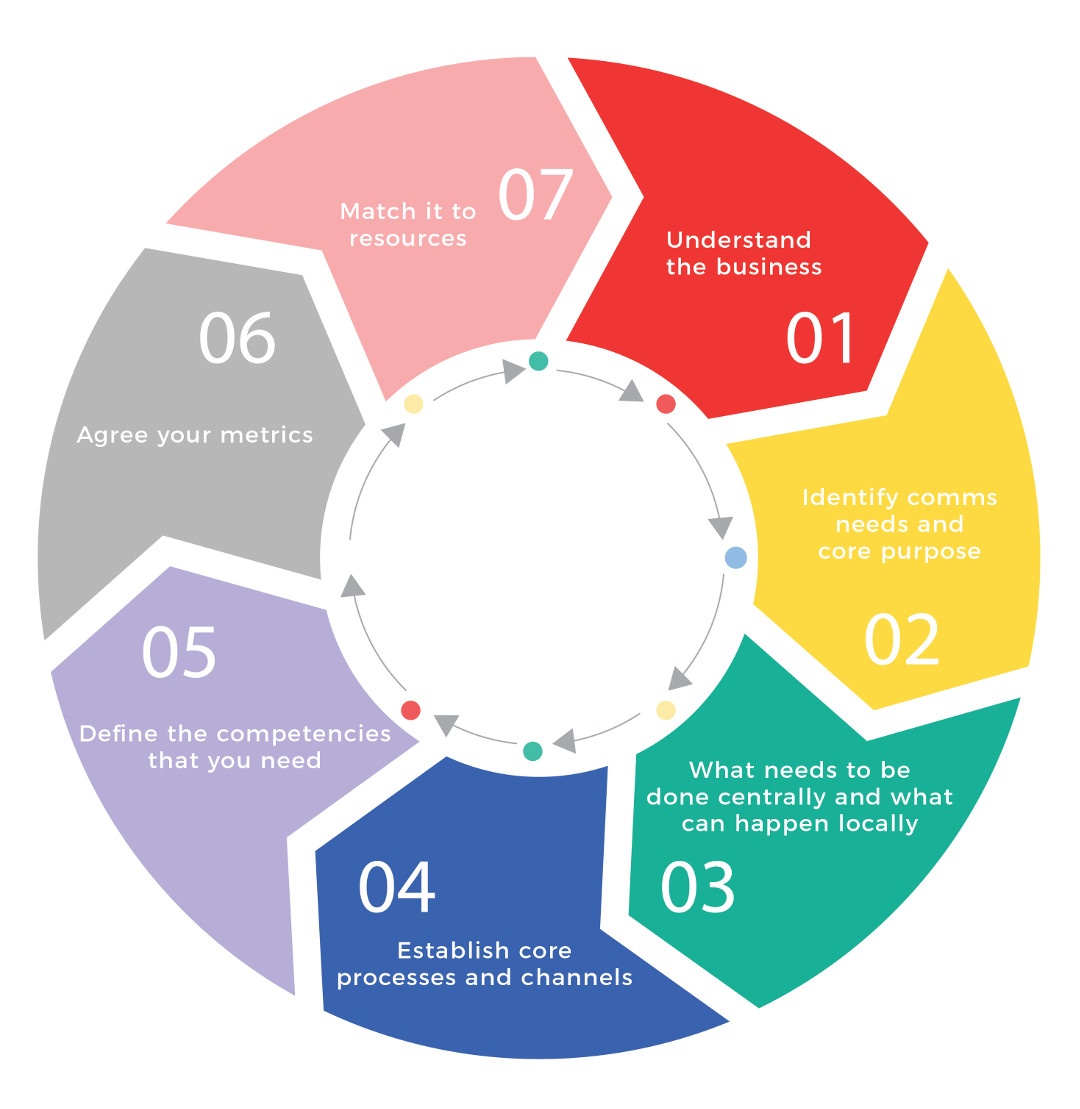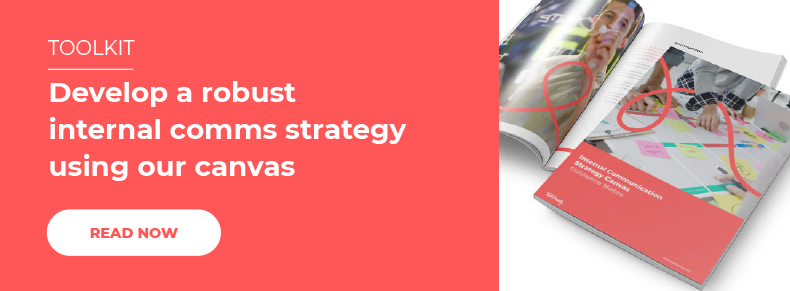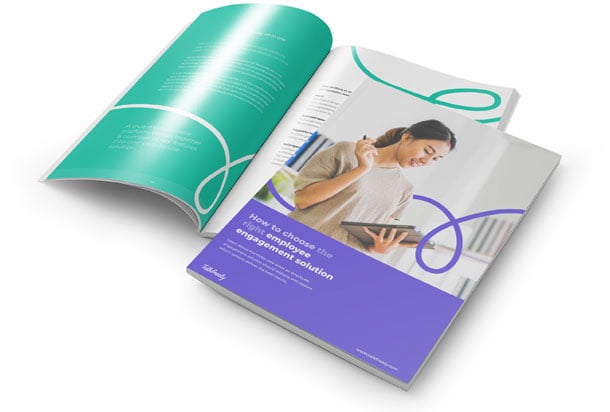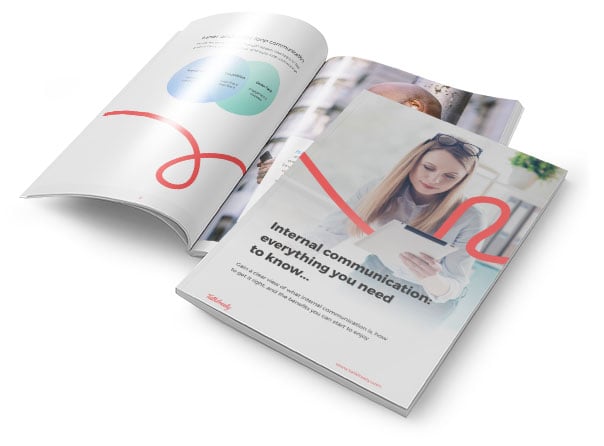What’s the secret to success when it comes to internal communications? Forward planning. It’s the one area of business where you simply can’t get away with winging it. Unless you put some serious time and thought into your communications, you’ll find your messages fail to meet their mark. Every organisation needs a carefully planned internal communication strategy to connect with its employees successfully.
Your internal comms strategy is especially important in times of difficulty. When the chips are down, and you need every employee to rally to the cause, effective internal communication becomes more important than ever. Change is also a big disrupter for office staff. New hybrid working patterns have turned the modern office environment upside down. This new way of working brings a level of adjustment that requires careful navigation. Get it wrong, and you’ll find morale takes a downward turn.
Your internal communications strategy could mean make or break for your company. If your strategy is working well, you’ll find your employees are ready to move quickly and adapt easily to moving goalposts and requirements. With an ineffective setup, you’ll meet with resistance and fear. Strategic internal communications are needed to break the natural opposition to change and new working methods.
In this blog, we take an in-depth look at how to implement an internal communication strategy template. We examine the structure and objectives of a successful strategy and highlight the key do’s and don’ts you need to consider when putting your plans into place. We also look at the key elements that make up internal communication strategies to ensure your approach is on track for success.
Your Internal Communication Strategy: The Objectives
The best internal comms strategy will help your organisation speak with a consistent voice. Every single employee must have a clear view of:
- The overarching vision and specific business goals
- The individual part they have to play in achieving them
An effective internal communications strategy is fundamental in times of change or difficulty when the messages circulating internally have to match what employees are reading in the press or on social media outside. Internal and external communication must always work in tandem in these circumstances. Communicating change requires your strategy to be infallibly robust.
Your core strategy should therefore be to:
- Ensure every communication is dovetailed to specific business goals
- Give employees what is known as “line of sight”: this is when they grasp the company’s overall vision and their personal role within it
- Make sure every activity leads to action that changes something
An excellent guide to defining what your internal communications plan needs to do is Quirke’s model, which charts the interest an employee has in a message against the impact it will have on them. You can use this table to work out what form your communications should take:

Internal Communication Strategy Basics: Building a Team
When setting up a team, it can be helpful to think about a virtuous circle. An excellent model of an internal communications strategy example is provided by FitzPatrick, as reproduced below:

The recommended process starts by defining what you need and then adapting those needs to fit what is possible with your budget. By taking the time to identify your core purpose, processes and channels at the start, you’ll be able to refine and hone your team to your exact requirements.
It’s also vital to agree on how you’ll measure the efficacy of your team. Tracking internal communication metrics is an essential part of any strategy implementation. Communication is a two-way process, so you will also need to see how your audience is reacting so that you can amend, repeat or build on your message as required, and adapt your team to suit. An internal communications app will have dashboards and reporting built into the system to help you keep your finger on the pulse at all times.
One of the questions that often arises is where the team should sit. This problem occurs because:
- HR thinks Internal Communication is a natural fit with the central mission of people management, so it should be incorporated into the HR department.
- PR people want to own Internal Communication so they can align it with external messaging.
- Marketing wants to make sure their staff are delivering the right messages when they talk to customers.
However, where your desks and chairs are situated matters far less than understanding what you are trying to change and where you can add value to the business. Internal communication will happen no matter where the central team is sitting. Your priority should be how to make it count. And the way to do that is by focusing on your internal communication strategy and action plan.
Internal Communication Strategy Example: The Key Elements
What needs to be included in your internal communication strategy? Here’s an internal communications strategy example to help you tie down the foundations of any plan. These five key features will help you to define what you need to say, and how you need to say it.
1. A defined audience
Always start with this one. Your strategic communications are only strategic if they’re tailored to the audience who receives them. Define who your audience is, and consider their experiences, expectations and levels of knowledge and understanding. You also need to consider their priorities and level of trust in the organisation. Effective communication in the workplace is dependent on this understanding.
2. A clear context
So, now you know who you’re speaking to. Next, you need to determine the context in which you’re addressing them. It’s important to recognise the key events - past, present and future - and assess how their significance will impact your communications. What is happening in your audience’s lives? What have their recent experiences been? How are they expecting their future to look?
3. A specific outcome
What are you trying to achieve? It’s an obvious question, but often overlooked. Whether it’s information transfer, instruction, transformation, or persuasion, each purpose will need a different approach to be successful. A straightforward method to try is the ‘Head - Heart - Hands’ technique. Ask yourself these three questions to help define your call to action:
- Head - what do people need to know?
- Heart - what do they need to believe?
- Hands - what do they need to do?
4. An effective channel
How you distribute your message is as important as what you say. There are many internal communication channels to choose from, from simple emails to Teams calls to all-hands-on-deck conferences. An internal communications app is quickly becoming the channel of choice for many organisations. That’s because it cuts through the barriers of resistance by allowing staff to use their own devices to receive and respond to messaging.
5. A measure of success
How will you know if your internal communication strategy is working? By conducting an analysis of engagement levels with regular and scheduled check-ups. By continually evaluating engagement, you’ll be able to tweak your strategy to ensure it’s delivering the maximum impact. Monitor the ongoing health of your organisation and the impact of your comms, and you’ll find that your strategy improves and adapts as you go along.
Internal Communication Strategy Template: Using a Canvas
Not sure where to start? Consider using a canvas to help you visualise your approach. A canvas is a diagram that gives a broad overview of your current business needs. Or, in other words, an internal communications strategy template. It will help you select and improve internal communication channels, identify risks and challenges, and highlight areas to target. These internal communication strategy examples will help you focus on what needs to be done, without wasting time getting bogged down in the details. A canvas is one of the crucial internal communication best practices that shouldn’t be overlooked.
When you use a canvas to structure your internal communications strategy, you’re ensuring that you create a comprehensive plan that:
- Covers all aspects of the business
- Includes every employee
- Fulfills every objective
- Measures the impact
Talkfreely has produced an internal communications strategy template along with a 20-page guide that will help you to define your strategy. The guidance notes will help you to complete the internal communication strategy template, giving you a solid framework for defining goals and shaping communication channels within your organisation. Put simply, this internal communication strategy and action plan pdf is the blueprint for success.
Internal Comms Strategy: The Six Do’s
Looking for internal communication ideas to bring your strategy up to scratch? You will need to make sure your internal comms strategy template can do these six key things:
1. DO deliver quality content and tools
Your writing needs to be right on the mark if you’re going to connect with your audience, tailored precisely to their needs. The design of your communications needs to be top-class. And your internal communication tools and channels must be faultless in their delivery. This is essential to getting information out there when and how it is needed, whether through an engaging staff survey, app or a clip on your corporate YouTube channel.
2. DO reach every single employee
Reaching the majority just isn’t enough. Effective communication in the workplace means reaching everyone without fail, whether they are working remotely from home, out on the road or situated in central office. It’s vital to connect with every member of staff, even the hard-to-reach remote workers and hybrid teams. An internal communications app will remove barriers by improving reach and allowing employees to use their favourite means of communication.
3. DO forge partnerships across the business
An essential element of any internal communication definition is the inclusion of business partnerships. Make it your mission to build relationships across the business with individual leaders or teams to address specific problems. These business partners can help local leaders communicate effectively and ensure the organisation’s central focus is not lost in a blur of activity. Don’t forget that good communication is the remit of everyone in leadership, so it is contradictory to believe that a single team can control all that is said.
4. DO offer strategic advice to leaders
The best way to deliver this crucial information? Implementing a regular internal communications survey. Compiling a data-driven analysis of how employees think and react will give you the information you need to predict how they will behave. This insight will set you apart from the guesswork of other senior people. When improving internal communications, nothing is more valuable than solid, reliable data.
5. DO be prepared for a crisis
Recent events have made this one of the critical internal communication trends of 2023. It’s essential to have a change strategy in place so that when the moment comes – probably unexpectedly – your employees are ready to mobilise, are excited about working in an uncertain climate with goalposts that keep shifting, and are keen to try out new tools and techniques. When it comes to communicating change, you will find it helpful to have different strategies for different stages of change:
- Stage 1: Prepare for change
- Stage 2: Manage the change
- Stage 3: Re-connect with staff to sustain the change
6. DO measure the success of your strategy
Unless you make it your mission to track the impact of every communication, you’ll be shooting in the dark. Are your messages being read? And crucially, are they being understood and acted upon? This is where an employee app comes to the rescue. With built-in reporting, an internal communications app will make it simple to measure the success of your staff communication strategy. If it does not have the impact you desire, this data gives you the power to change it for the better.
Internal Comms Strategy: The Six Don’ts
Equally as important as the previous list, these six common internal communication mistakes should be avoided at all costs. While a robust strategy will propel your business to new heights, a poorly performing internal communications strategy could cost you dearly.
The following errors are seen in many strategies, often based on the assumption that everyone works and thinks similarly. If only it were that easy!
1. DON’T believe that one message is enough
It’s a mistake to think that a single message expressed in the right way will reach and be understood by every employee. There are seven billion varieties of humans, and everyone will interpret your message slightly differently. The internal communication process is a complex one. Don’t assume that one document or campaign will do the job for everyone. In an engineering firm, for instance, PhDs will rub shoulders with school-leaver apprentices. They are likely to need different amounts of information. Keep putting your message over in various ways through various channels, and it will eventually make its mark.
2. DON’T assume change will be welcomed
The change that galvanises leaders will likely be received differently by those further down the pecking order. They may be afraid of the disruption it brings. When communicating change, you must always be aware of the invisible barriers that need breaking down before your message gets through. For example, beware of communicating the same upbeat message about axing an unsuccessful product to shareholders and shop floor alike. Change needs careful handling, and assuming it will be good news for all is a mistake. When developing your internal communication strategy template, this needs to be kept in mind.
3. DON’T depend on a single communication channel
Don’t try to communicate with factory workers through an intranet they probably never get to see or use the company newsletter to talk to van drivers on the road all day. The main reason employee intranets fail to engage employees is that they don’t consider whether everyone can access it successfully. This is where an internal communications app that connects across multiple communication channels really comes into its own.
4. DON’T make rank-based assumptions
Many internal communications teams mistakenly believe someone on the shop floor cares nothing for the organisation’s big-picture future. Likewise, higher up the hierarchy, you may find timeservers with no interest in what’s happening outside their own job spec. The role of internal communication is to engage with all employees consistently, ensuring everyone receives the same information simultaneously, regardless of rank or status. A corporate internal communications strategy needs to address everyone equally.
5. DON’T forget to include some fun
An internal corporate communication strategy all too often focuses on dry and unexciting content. Yes, it’s essential to relay the latest sales figures and CEO reports but remember that your audience will also enjoy the lighter side of life. Effective internal communication is a mix of company news, knowledge, ideas, feedback and fun. If you simply focus on the company news, you’ll lose your audience. Throw in some messaging about social events, personal achievements and fun moments around the office. You could send out a light-hearted poll or competition. Make it fun, and your audience will show their appreciation.
6. DON’T try to control every communication
Do not think you have to control or shape every message that goes out to your organisation – it’s a fallacy that will only waste your time and probably drive you mad. The secret to success is ensuring your critical communications are handled clearly and consistently across the company. Not every email needs to be monitored. Give time to the critical campaigns, and don’t sweat the small stuff.
Conclusion
These internal communication strategy examples should set you on the road to success.
In times of change and uncertainty, it’s more important than ever to have a robust internal communication strategy in place. The best strategy will ensure that your employees are primed and ready to adapt to change and kept informed with a steady flow of consistent messages. Reaching every employee ensures that the company's vision and aims are followed. Forward planning is the answer.










